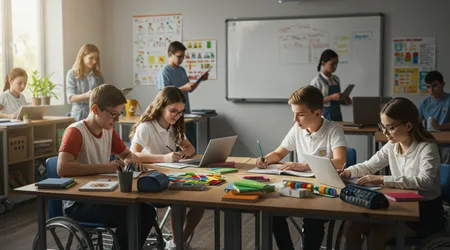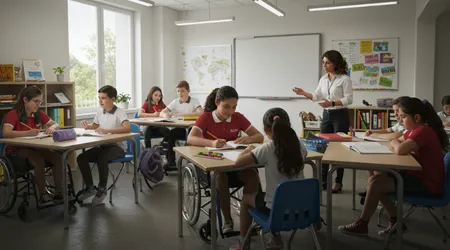Inclusive Education in 2025: Global Best Practices You Should Know

Inclusive Education in 2025 stands at the forefront of global educational reform, weaving equity and access into the fabric of learning systems.
It’s no longer just a buzzword it’s a movement reshaping classrooms worldwide, ensuring every student, regardless of ability, background, or circumstance, thrives.
As we navigate a world driven by technological advancements and social justice imperatives, inclusive education evolves to meet diverse needs with precision and empathy.
This article dives deep into the most effective global practices, offering actionable insights for educators, policymakers, and advocates.
From cutting-edge technologies to culturally responsive pedagogies, we’ll explore how schools are breaking barriers and fostering belonging. Why settle for outdated systems when the future of education is here, now?
The urgency of inclusive education stems from a global recognition that diversity strengthens learning environments. UNESCO’s 2025 report highlights that 60% of children with disabilities in low-income countries still lack access to quality education.
This statistic isn’t just a number it’s a call to action. Schools must adapt to diverse needs, from neurodiversity to socioeconomic challenges, ensuring no one is left behind.
Inclusive Education in 2025 demands creativity, collaboration, and a commitment to equity, blending technology with human-centered approaches.
Let’s unpack the strategies driving this transformation, with real-world examples and practical steps to inspire change.
Universal Design for Learning (UDL): A Blueprint for Access
Imagine a classroom where every student engages with content in their own way some through audio, others via visuals, and some through hands-on activities.
That’s the essence of Universal Design for Learning (UDL), a framework prioritizing flexibility in teaching methods. UDL ensures materials and assessments cater to diverse learners, from those with physical disabilities to gifted students.
In 2025, schools in Finland lead the charge, using UDL to create adaptable lesson plans. Teachers there offer multiple formats text, video, or interactive simulations ensuring all students access content meaningfully.
UDL’s strength lies in its proactive approach. Instead of retrofitting lessons for specific needs, it builds inclusivity from the start.
For example, a science teacher in Helsinki uses UDL by providing digital simulations for visually impaired students and hands-on experiments for kinesthetic learners.
++ How AI-Powered Personalized Learning is Transforming Inclusive Education
This approach boosts engagement across the board. Schools adopting UDL report higher student satisfaction and lower dropout rates.
By designing lessons with universal access in mind, educators create environments where differences are strengths, not obstacles.
Another layer of UDL’s impact is its scalability. In rural Australian schools, UDL integrates with low-tech solutions like printed braille resources and peer-led discussions.
This adaptability ensures inclusivity even in resource-scarce settings. Teachers can start small offering choice in assignments, like essays or presentations to see immediate engagement spikes. Isn’t it time we stopped forcing students into one-size-fits-all molds?

Technology as a Game-Changer
Technology in Inclusive Education in 2025 isn’t just a tool it’s a lifeline for students with diverse needs. Assistive technologies, like AI-driven text-to-speech software, empower students with dyslexia to engage with texts independently.
In Singapore, schools use augmented reality (AR) to create immersive learning experiences for autistic students, helping them visualize complex concepts like ecosystems.
These tools don’t replace teachers; they amplify their impact, making lessons accessible and engaging.
Consider the case of Maria, a visually impaired student in Brazil. Using real-time audio description software, she navigates virtual classrooms with ease, participating in group projects.
Such technologies bridge gaps that traditional methods couldn’t. UNESCO IITE’s 2025 report notes that AI tools increase access for students with disabilities by 40% in tech-equipped schools. Yet, the digital divide persists rural areas need affordable solutions to keep pace.
Also read: Adapting Science Labs for Physical and Cognitive Accessibility
Beyond accessibility, technology fosters collaboration. In Canada, virtual reality platforms allow students with mobility challenges to join field trips virtually, exploring museums alongside peers.
Schools can implement tech by starting with free tools like Google’s accessibility features. Training teachers to use these tools effectively is key to maximizing their impact.
Culturally Responsive Teaching: Honoring Diversity
Education must reflect the world’s mosaic of cultures, especially in Inclusive Education in 2025. Culturally responsive teaching (CRT) integrates students’ backgrounds into curricula, fostering belonging.
In New Zealand, Māori cultural practices are woven into lessons, boosting engagement among indigenous students. Teachers use storytelling and local history to make lessons resonate, proving that inclusion goes beyond disability it’s about identity.
CRT requires teachers to understand their students’ lived experiences. In South Africa, educators incorporate local languages into math lessons, reducing language barriers for non-English speakers.
This approach builds confidence and academic success. Schools can adopt CRT by training teachers to recognize cultural biases in materials and adapt lessons accordingly. For example, using diverse literature ensures all students see themselves in stories.
Read more: Supporting College Students with ADHD Beyond Accommodations
Engagement isn’t the only benefit CRT reduces dropout rates. In the U.S., schools using CRT report a 15% decrease in absenteeism among minority students.
Teachers can start by auditing curricula for cultural relevance, ensuring lessons reflect diverse perspectives. This practice doesn’t just teach it transforms lives by validating identities.
Collaborative Partnerships: Schools, Families, Communities
Inclusion thrives when schools don’t operate in silos. In Inclusive Education in 2025, partnerships with families and communities are vital.
In Japan, schools host regular workshops where parents learn to support their child’s unique needs, from ADHD to giftedness. These collaborations build trust and ensure consistent support across home and school environments.
Communities also play a role. In Kenya, local NGOs partner with schools to provide resources like wheelchairs and braille materials.
This collective effort ensures students with disabilities aren’t excluded due to resource shortages. Schools can initiate partnerships by hosting community forums, inviting input on inclusive practices. Such collaboration creates a support network that uplifts every student.
Another example comes from the UK, where schools collaborate with mental health organizations to support students with anxiety.
These partnerships offer counseling and coping strategies, reducing academic stress. By involving families and communities, schools create ecosystems where inclusion is a shared responsibility, not just a teacher’s burden.
Teacher Training: The Heart of Inclusion
No practice succeeds without skilled educators. In Inclusive Education in 2025, robust teacher training is non-negotiable.
Norway’s teacher education programs now include mandatory modules on inclusive practices, covering everything from UDL to behavior management. This equips teachers to handle diverse classrooms with confidence and creativity.
Training must be ongoing, not a one-off. In India, micro-credential programs allow teachers to specialize in areas like autism support or bilingual education.
For instance, a teacher in Mumbai uses these skills to create individualized plans for students with learning disabilities, boosting their academic outcomes. Schools can invest in training by partnering with universities or online platforms like Coursera.
The impact is clear: well-trained teachers reduce classroom exclusion. A 2025 study by the OECD found that trained teachers improve student participation by 25%.
Schools can start with workshops on empathy-driven teaching, ensuring educators understand diverse needs. Without this foundation, even the best tools fall short.
Policy and Advocacy: Driving Systemic Change

Policies shape the backbone of Inclusive Education in 2025. Countries like Sweden enforce strict inclusion mandates, requiring schools to accommodate all learners.
These policies ensure resources, from ramps to trained aides, are available. Advocacy groups play a crucial role, pushing for laws that prioritize equity over compliance.
In Brazil, parent-led advocacy has led to increased funding for inclusive schools, ensuring access to assistive technologies.
Schools can advocate by joining national inclusion networks, amplifying their voices. For example, a school in São Paulo partnered with a disability rights group to secure funding for sensory rooms, benefiting autistic students.
Global frameworks, like the UN’s Sustainable Development Goal 4, emphasize inclusive education.
Schools can align with these goals by auditing compliance and lobbying for local policy changes. Strong policies ensure inclusion isn’t optional it’s systemic, sustainable, and transformative.
Measuring Success: Data-Driven Inclusion
Tracking progress is critical in Inclusive Education in 2025. Data-driven approaches help schools assess inclusivity’s impact.
In Australia, schools use dashboards to monitor student engagement, attendance, and academic growth across diverse groups. This data guides resource allocation, ensuring no student slips through the cracks.
For example, a school in Sydney uses analytics to identify struggling students early, offering tailored interventions like peer tutoring.
The table below, drawn from UNESCO’s 2025 data, shows how data-driven strategies improve outcomes:
| Metric | Inclusive Schools | Non-Inclusive Schools |
|---|---|---|
| Student Engagement | 85% | 60% |
| Dropout Rate | 5% | 15% |
| Academic Achievement | 80% | 65% |
Schools can adopt this by using free tools like Google Analytics to track user behavior on digital platforms.
Regular surveys also capture student and parent feedback, refining inclusive practices. Data isn’t just numbers it’s the key to meaningful change.
Another practical step is benchmarking against global standards. Schools in Germany compare their inclusion metrics with EU guidelines, identifying gaps in accessibility.
This ensures continuous improvement. By measuring success, schools turn good intentions into tangible outcomes, creating environments where every student thrives.
A Call to Action: Building Inclusive Futures
Inclusive Education in 2025 isn’t a destination it’s a journey toward equity and opportunity. From UDL’s flexible frameworks to technology’s transformative power, global best practices show what’s possible when we prioritize every learner.
Culturally responsive teaching and collaborative partnerships weave communities together, while teacher training and strong policies lay the foundation for lasting change. Data-driven strategies ensure we’re not just hoping for inclusion but achieving it.
The path forward requires action. Schools must adopt these practices, starting small but thinking big. Whether it’s integrating AI tools or auditing curricula for cultural relevance, every step counts.
Think of inclusion like a garden: plant the seeds of equity today, nurture them with care, and watch a vibrant, diverse community bloom. The 60% of children still excluded from quality education deserve better let’s make it happen.
Educators, policymakers, and communities must unite to sustain this momentum. By sharing resources, advocating for change, and measuring progress, we can ensure no student is left behind.
The future of education is inclusive, accessible, and empowering. Will you join the movement to make it a reality?
Frequently Asked Questions
What is the most effective way to start implementing inclusive education?
Begin with UDL, offering flexible learning options like videos or hands-on tasks to meet diverse needs.
How can schools afford inclusive technologies?
Leverage free tools like Google’s accessibility features and partner with NGOs for funding assistive devices.
Why is teacher training critical for inclusion?
Trained teachers adapt lessons effectively, boosting participation by 25%, as shown in OECD’s 2025 study.
How does culturally responsive teaching improve outcomes?
It validates student identities, reducing absenteeism by 15% in U.S. schools using diverse curricula.
What role do parents play in inclusive education?
Parents collaborate through workshops, ensuring consistent support, as seen in Japan’s inclusive programs.
